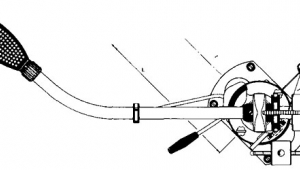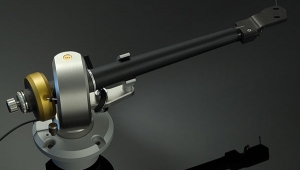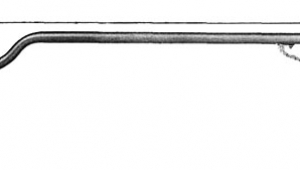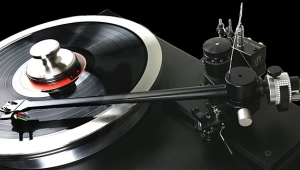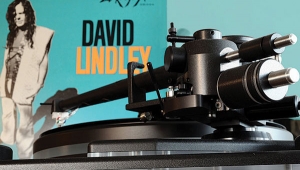| Columns Retired Columns & Blogs |
HiFiction Thales AV tonearm Page 3
If you set your stylus rake angle (SRA) to 92° using an LP of medium thickness (150gm), that setting should suffice for all thicknesses of vinyl, given how much movement would be required at the rear end of the arm to produce a change in SRA of even 1°. If you set it by ear, just be careful, and tighten the grub screw when you're done.
Setting the antiskating force requires you to turn a disc on a threaded rod under the rear cardanic bearing. Here, again, you must exercise extreme caution. Without a test LP such as Telarc's out-of-print Omnidisc, setting antiskating on the Thales AV is next to impossible. It comes preset, but when I used the Omnidisc test track, I found the Thales undercompensated; I ended up rotating the Thales AV's antiskating wheel outward until mistracking occurred simultaneously in both channels. (I wish someone would duplicate this track on a new test LP.)
Use
Because the Thales AV's cueing platform and an edge of its cardanic bearing protrude over the platter, you must slide LPs under the cueing platform before lowering them onto the spindle. The maneuver isn't difficult, but it must be done with care. If the fit of spindle to hole is tight, removing the record can be a hassle and—if the LP suddenly comes loose and bangs into the arm, which can't be locked in place—a potential stylus destroyer.

The cueing mechanism is smooth but undamped; again, proceed cautiously. Also, the placement of the horizontally swiveling cueing lever requires you to reach under the horizontal arm, which you must be careful not to bang into. If you do, you can knock the bearings out of their cups and collapse the entire mechanism. If that happens, the horizontal arm falls down, the vertical arm falls forward, and at first you'll think you've broken everything. But don't panic—just use your cartridge's stylus guard, carefully reattach the bearings, and you're good to go. I don't recommend using a cartridge that doesn't come with an easily attached stylus guard—at least, not until you're secure and comfortable with the HiFiction's operation.
Once I'd familiarized myself with its operation, the Thales AV was as easy to use as any pivoted tonearm, and easier to set up and use than most linear-tracking arms. What's more, when I lowered the stylus into a groove, there was none of the wobbling and settling exhibited by many conventional linear trackers. The Thales AV's rock-solid stability was instantaneous.
Sounds linear, too!
Because of the Thales AV's low back end, it couldn't be mounted on my reference turntable, the Continuum Audio Labs Caliburn. Instead, I listened to it as mounted on the unfamiliar Audiostone Pythagoras turntable (see "Analog Corner" in the September issue). Yes, this means I changed two variables at once, and had the experience proved unpleasant, I wouldn't know where to lay the blame, but since this new combination provided the first real competition for Continuum's Caliburn 'table and Cobra arm since they were installed here five years ago, I'm certain that the sound of the HiFiction, like its qualities of construction and finish, is everything one should expect and demand for $89,500.
Micha Huber set up the Lyra Titan i cartridge in the Thales AV, and it remained on the arm for well over a month. Within minutes of beginning my listening, my concerns about the arm's ability to dissipate resonant energy, due to those bearings at the rear of the headshell, had vanished.
The HiFiction's low-frequency performance was as clean, deep, well textured, and well controlled as the Cobra's, based on a comparison of CD-R recordings I'd made when the Titan i was last on the Cobra and the Boulder Amplifiers 2008 phono preamp (currently on loan) was last in my system. In fact, I heard slightly more bass weight—but it was impossible to figure in any contributions the Audiostone Pythagoras might have been making.
Bottom line: As far as I could hear, in terms of energy transfer, no penalty was paid for any of the Thales AV's additional pivot points. Using the Hi-Fi News & Record Review Test Record (LP, HFN 001), both horizontal and vertical resonant frequencies were at 10Hz, within the desirable range of 8–12Hz. No tangential tracker in my experience has produced that result in both planes.
The advantages of true tangential tracking were obvious from the outset. Transient and sibilant cleanness were consistent across the record surface, even with the most demanding LPs. While tracking-error distortion isn't bothersome or even readily noticeable with a conventional pivoted arm that's been properly set up, its complete absence can be detected in direct A/B comparisons. I swapped out cartridges, putting the Titan i on the Cobra and an Ortofon A90 on the Thales, and got the same results playing a series of sibilant-rich recordings of male and female voices. The differences weren't profound—I was comparing two state-of-the-art tonearms, each costing more than $12,000—but the superiority of the Thales AV was occasionally noticeable, as was this tonearm's unvaryingly stable imaging and soundstaging.
Along with the HiFiction's superb general tracking abilities, its tonal balance (compared with an unknown turntable) produced no obvious colorations, though the overall balances of the Cobra-Caliburn and Thales-Pythagoras were somewhat different. Unfortunately, under these circumstances it's impossible to know whether the arm, the 'table, or both accounted for the minor differences, so I see no point in going into them in detail.
That said, the Thales AV was as open and resolving and well detailed as any tonearm I've heard. Its upper-octave performance was as airy and open as the best I've heard, and its bottom end was equally fine. Were the Rega RB300 the only tonearm you'd ever heard, you might faint the first time the Thales played you your favorite reference LP. And the Thales did the zero-tracking-error trick with no tradeoffs that I could hear or measure or conceive of, based on my understanding of tonearm design.
While it looks delicate and the whole thing collapses if the horizontal arm is jarred, unlike Humpty Dumpty, it's easily put back together again. After all, it's built like a Swiss watch by an actual Swiss watchmaker who, given this magazine's demographics, is likely to outlive us all. With reasonable care, the Thales AV should prove robust, reliable, and long-lived.
Conclusions
The HiFiction Thales AV made it possible for both the Lyra Titan i and the Ortofon A90 cartridges to reach their full sonic potentials in my system. The arm tracked as well as any pivoted tonearm I've used. If Micha Huber's geometry is correct, and his engineering as accurate as it appears to the naked eye, then the final product actually did perform with zero tracking error, which I heard as ultraclean transient and sibilant performance, and solid, stable, consistent imaging across the entire record surface. No, it couldn't track Telarc's cannonade in Tchaikovsky's 1812 Overture, but what arm can? And who cares?
The Thales AV and the Thales Original arm are expensive. They are also genuine breakthrough products that at last realize, with no discernible downside, audiophiles' long-held dream of tracking LPs in the same way the lacquers from which they were pressed were originally cut.
- Log in or register to post comments


